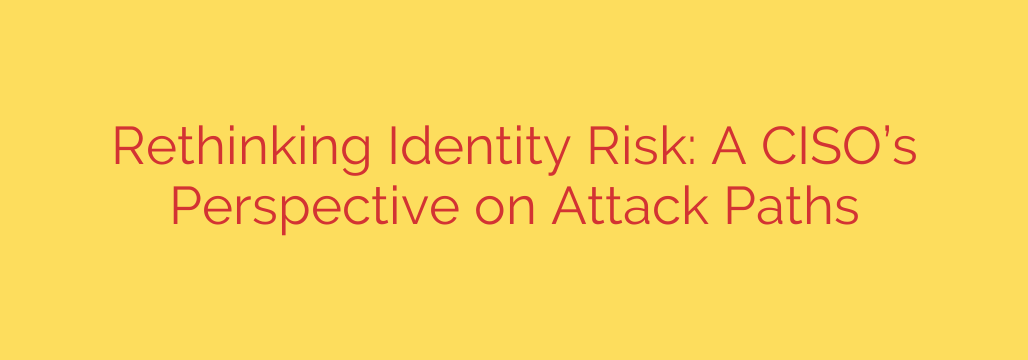
A CISO’s Guide to Mastering Identity Security and Attack Paths
In today’s complex digital landscape, the old “castle-and-moat” approach to cybersecurity is no longer sufficient. With the rise of cloud infrastructure, remote work, and interconnected SaaS applications, the traditional network perimeter has all but dissolved. The new perimeter, and the primary target for modern adversaries, is identity.
Security leaders must fundamentally rethink how they approach risk. It’s no longer just about preventing a breach at the edge; it’s about understanding how an attacker, once inside, can leverage identities to navigate through your systems and reach your most critical assets. This is the core of understanding and mitigating identity-based attack paths.
The Critical Shift: Attackers Don’t Hack In, They Log In
For years, the focus of identity and access management (IAM) has been on authentication and authorization. We ask: “Is this user who they say they are?” and “What is this user allowed to access?” While important, these questions miss a crucial third dimension: “What can an attacker actually do with this user’s access?”
The reality is that sophisticated attackers are not just looking for a single set of high-value credentials. They are looking for any foothold. A compromised account belonging to a low-level employee or a misconfigured service account can be the starting point of a devastating attack chain.
An attack path is the sequence of steps an adversary can take by exploiting chained permissions and privileges to move from their initial entry point to a high-value target. They might use one identity to access a server, discover another set of credentials on that server, and then use those to escalate their privileges until they control a critical database or domain controller.
The Hidden Dangers of “Permission Sprawl”
Many organizations suffer from a condition known as “permission sprawl.” Over time, users and service accounts accumulate access rights that are no longer necessary for their roles. This creates a tangled web of entitlements that is nearly impossible to manage manually.
The danger isn’t just one over-privileged account; it’s the toxic combination of seemingly low-risk permissions across multiple accounts that can create a hidden super-highway for an attacker.
Consider this scenario:
- A marketing contractor’s account has read access to a specific cloud storage bucket.
- Within that bucket is a configuration file containing credentials for a legacy service account.
- That service account has administrative privileges on a development server.
- The development server has a trust relationship with the production environment.
Individually, each permission might seem acceptable. However, when chained together, they form a clear and exploitable attack path from a low-privilege contractor to your production environment. This is the blind spot for many traditional security tools, which analyze permissions in isolation rather than as an interconnected graph.
A Modern Framework for Identity Risk Management
To effectively combat these threats, Chief Information Security Officers (CISOs) and their teams must adopt a new, path-based approach to identity security. This involves shifting from a static, list-based view of permissions to a dynamic, graph-based understanding of access relationships.
Here are actionable steps to build a more resilient identity security posture:
1. Visualize and Map All Potential Attack Paths
You cannot protect what you cannot see. The first step is to gain complete visibility into every possible identity-based attack path within your environment, including on-premises, cloud, and multi-cloud systems. This requires tools that can automatically map the complex relationships between all identities (human and machine) and all resources. This mapping must highlight the “toxic combinations” of permissions that create risk.
2. Prioritize Risks Based on Business Impact
Not all attack paths are created equal. A path leading to a test server is far less critical than one leading to your customer financial data. By connecting attack path analysis to your “crown jewel” assets, you can prioritize remediation efforts effectively. Focus on severing the attack paths that pose the most significant and immediate threat to the business. This allows you to allocate security resources intelligently and demonstrate clear risk reduction to the board.
3. Proactively Eliminate High-Risk Entitlements
Once you have visibility and have prioritized risks, the next step is proactive remediation. This goes beyond simple password resets. It means strategically removing excessive, unnecessary, or dormant permissions that form the links in an attack chain. Enforcing the Principle of Least Privilege is paramount. Every identity should have only the minimum access required to perform its function, and this access should be reviewed regularly.
4. Implement Continuous Monitoring and Detection
Your environment is constantly changing. New users are onboarded, applications are deployed, and permissions are modified every day. A one-time audit is not enough. Effective identity security requires continuous monitoring to detect new attack paths as they emerge. Implementing Identity Threat Detection and Response (ITDR) capabilities allows you to spot anomalous behavior—like an account suddenly accessing unusual resources—and respond before an attacker can complete their mission.
Redefining Security for an Identity-First World
The conversation around identity risk must evolve. It’s no longer enough to build walls and hope for the best. Security leaders must assume that attackers will find a way in. The crucial question is: What can they do once they are there?
By focusing on discovering, prioritizing, and remediating identity attack paths, organizations can move from a reactive to a proactive security posture. This modern approach not only hardens defenses against sophisticated attacks like ransomware and data exfiltration but also provides a quantifiable way to manage risk and protect the assets that matter most.
Source: https://www.helpnetsecurity.com/2025/07/30/ciso-attack-path-management-apm/








